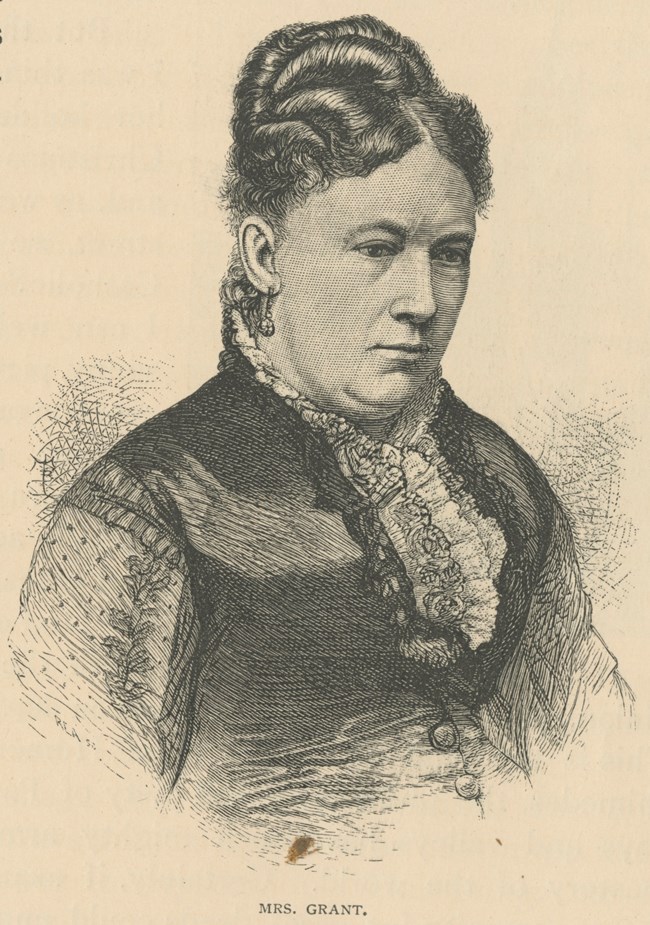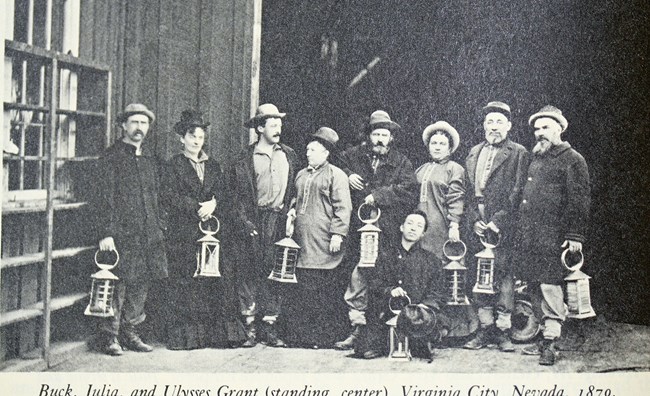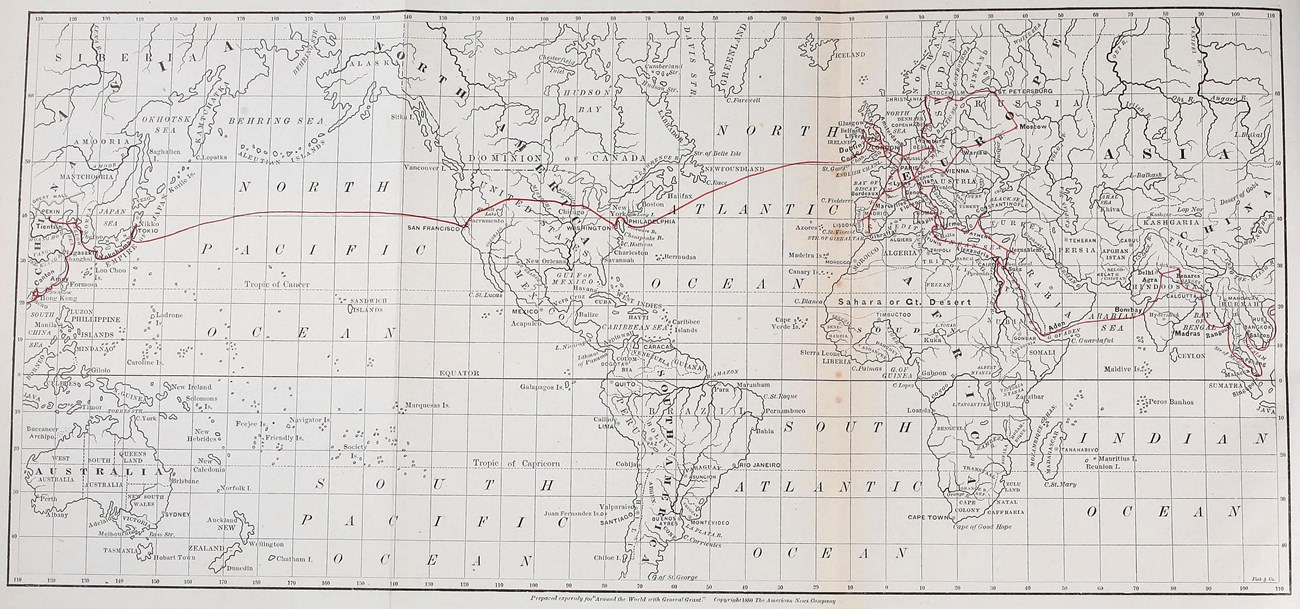Last updated: May 31, 2024
Article
The Grants' World Tour

Around the World with General Grant
Ulysses S. Grant served as President of the United States from 1869-1877. This period signified the rise and fall of Reconstruction, a prolonged effort to reunify the United States and gaurantee civil rights for all. While President Grant had his successes, his presidency was a stressful eight years also marked by challenges, frustration, and disappointment.
Upon leaving the White House, the Grants sought a quieter life as private citizens. They initially planned a vacation to England to visit their daughter Nellie, who had married Englishman Algernon Sartoris at the White House in 1874. However, the voyage quickly mushroomed into an unprecedented two-and-a-half year tour through Europe, the Middle East, Asia, and North America.
The Grants were greeted with parades and thunderous applause from common citizens, dined with royalty, and received lavish gifts. It was the grandest tour an American couple had ever made at that time and signified international recognition of the United States as an emerging world power.

Around the World with General Grant
On May 17, 1877, Ulysses and Julia Grant left Philadelphia on the steamer Indiana with their son Jesse and New York Herald journalist John Russell Young (who later documented the trip in Around the World with General Grant). They arrived in Liverpool 11 days later, where immense crowds welcomed them. Similar scenes occurred in London, Birmingham and Newcastle, where workers enthusiastically greeted the former American President. In the textile city of Manchester, Grant was moved by the reception he received in a city that had strongly supported the Union’s efforts during the Civil War despite its need for Confederate cotton. The working class found a hero in Ulysses S. Grant.
The English aristocracy lauded the General and Mrs. Grant as well. The Grants attended the Royal concert at Buckingham Palace, enjoyed the horse races with the Prince of Wales, and dined with Queen Victoria at Windsor Castle. They toured Shakespeare’s Stratford and Sheffield’s steel mills, then later went to Belgium, France, Italy, Spain, and Russia, among other countries. Wherever they went, citizens from all walks of life greeted them warmly.

Around the World with General Grant
Another noteworthy experience was had in Germany. While in the country the Grants travelled with British Prime Minister Benjamin Disraeli and were treated to music written and performed by Richard Wagner. Another highlight was the meeting between Grant and Germany’s Prince Otto von Bismarck. Smoking together at Radizwall Palace, Grant and Bismarck discussed America’s Civil War. They both declared their admiration for General Phillip Sheridan, as well as the necessity of preserving the Union.
Despite their vastly different characters and political beliefs, they found some common ground. Bismarck remarked that Grant “had to save the Union just as we had to save Germany.” Grant added, “Not only save the Union, but destroy slavery. As soon as slavery fired upon the flag it was felt, we all felt, even those who did not object to slaves, that slavery must be destroyed. We felt that it was a stain to the Union that men should be bought and sold like cattle. There had to be an end of slavery."
“It was a long war,” said Bismarck, “and a great work well done–and I suppose it means a lasting peace?”
“I believe so,” stated Grant.

Around the World with General Grant
The Grants were particularly captivated by Egypt and India, as well as the city of Jerusalem. It was a fascinating world which held the ancient mysteries of pyramids and ruins, and the modern realities of staggering poverty. They rode elephants, sailed on the Nile, explored sacred caves and temples, and Julia treated herself to jewelry and trinkets at the bazaars.
There was much here to excite the mind and spirit. Julia was deeply moved in Jerusalem, visiting the Christian holy sites at Bethlehem and Gethsemene. Ulysses marveled at the Hindu religion and its kindness and respect for man and animals, declaring that it was “a good system of morals for the guidance of its followers.”

Library of Congress
Like the Middle East, there was an exotic flavor to China and Japan. In China, huge crowds greeted the Grants, carrying them in chairs through the streets amidst the firing of cannon and the beating of gongs. Grant expressed sympathy for the bigotry the Chinese faced throughout the United States and the rest of the world, stating “I am not prepared to justify the treatment the Chinese have received at the hands of the foreigner.” Chinese General Li Hongzhang was so impressed that he asked Grant to intercede with the Japanese government regarding a territorial dispute. Grant’s desire to see disputes settled peacefully persuaded him to serve as an unofficial diplomat between the two nations.
Meanwhile, Grant found Japan “beautiful beyond description.” In a speech, he declared a “spirit of sympathy, support and reconciliation” with the Japanese, and stated how much America could learn from the East. The Grants visited the Nagasaki Art, Industrial and Science Fair, where they planted fig and camphor trees in honor of Japan. They wrote “I hope that both trees…in their growth, prosperity and long life be emblematic of the future of Japan.”

Library of Congress
The Grants landed in San Francisco, California on September 20, 1879. They then traveled to Yosemite Valley and Fort Vancouver, where the General visited the post where he was stationed as a young army officer over twenty-five years earlier. The Grants also explored the silver mines of Nevada, where Ulysses lost a bet that Julia would not descend into the mine. They were also honored with parades in Mississippi and Louisiana. The tour ended where it began, in Philadelphia, on December 16, 1879.
Never had a former president and first lady toured the world and been received with such honors. The Grants’ trip was more than a personal exploration of many diverse cultures. The General and his wife embodied the strength and character of a nation ready to play a vital role on the world stage, and the world took notice.

Around the World with General Grant
An Amazing Itinerary
The following list indicates the incredible scope of the Grants’ world tour. The destinations are listed in chronological order, but include various return visits to several places. At times, the Grants traveled so much in a short period that tracking them proves difficult.
England May-Sept. 1877, Jan. 1879
Belgium July 1877
Germany July 1877, June-July 1878
Switzerland July 1877, Sept. 1878
Denmark Aug. 1877
Scotland Aug.-Sept. 1877
France Oct.-Dec. 1877, May-June, Sept.-Dec. 1878, Jan. 1879
Italy Dec. 1877, March-May 1878
Egypt Jan.-Feb. 1878, Jan.-Feb. 1879
Palestine Feb. 1878
Turkey March 1878
Greece March 1878
Netherlands June 1878
Norway July 1878
Sweden July 1878
Russia July-Aug. 1878
Poland Aug. 1878
Austria Aug. 1878
Spain Oct.-Nov. 1878
Portugal Nov. 1878
Ireland Jan. 1879
India Feb.-March 1879
Burma March 1879
Siam April 1879
French Indochina April 1879
China April-May 1879
Japan June-Sept. 1879
